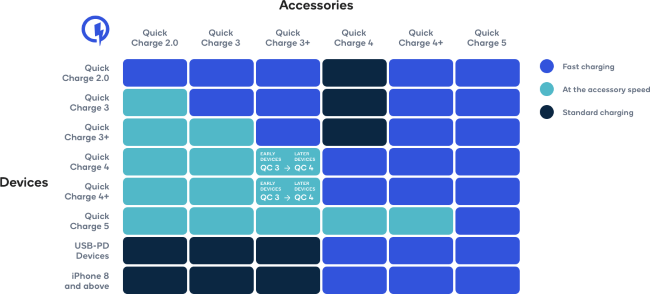Qualcomm Releases Quick Charge 5
14-08-2020 | By Robin Mitchell
Recently, Qualcomm has released its latest version of Quick Charge, a charging mechanism that drastically reduces charging times for modern devices. What is Quick Charge 5, how does it compare to previous versions, and what advantages does quick charging provide?
Modern Battery Technologies; why is Li-Ion so popular?
Batteries were one of the first sources of electrical power, and ever since have continued to be developed. Batteries are a critical component in modern devices as they allow for devices to be made mobile, and this has led to a range of different technologies ranging from asset tracking systems to smartphones. Like components, batteries are found in many different shapes and sizes, all of which have their areas of applications, advantages, and disadvantages.
One commonly used battery technology is lead-acid, which consists of different lead electrodes suspended in an acidic solution. These batteries are particularly useful at providing large amounts of current for a short time, and thus found in automotive applications (these can provide the power needed to rotate the driveshaft while also providing the energy required to drive the ignition system). Alkaline batteries are those that utilise an alkaline electrolyte (such as potassium hydroxide) and provide a long shelf life (when compared to those based on zinc chloride). These batteries are often found in households for use in remote controls, cameras, miniature speakers, and flashlights.
One battery technology that has gained massive amounts of popularity is the lithium-ion battery. Lithium-ion’s demand comes from their high energy densities, low-profile, low-weight, and ability to provide large instantaneous currents. While these batteries do come in cylindrical forms, they are often square in nature with a characteristic yellow top and built-in circuitry. Such batteries are increasingly replacing other battery technologies and now found in electric vehicles, smartphones, Bluetooth devices, and IoT sensors.
Disadvantages of Li-Ion Batteries
Li-Ion batteries are not without their flaws, and it is their high energy density that acts as a double-edged sword. A high-energy-density means that more energy is stored per unit volume when compared to low-energy-density batteries, thus in the event of a failure, more energy is released per unit volume.
In the case of Li-Ion batteries, failures often result in high temperatures which can cause fires, but the use of lithium also means that large quantities of hydrogen gas are also released. In the event of a failure, the hydrogen gas is often ignited, and the result is an incredibly dangerous situation that is almost ways destructive.
Lithium-ion batteries can undergo such a failure for multiple reasons, including mechanical damage, or overcharging. Mechanical damage (such as a puncture), can short cells together, which results in large amounts of current flow. The resulting current flow produces heat, and this heat can quickly reach the ignition temperature of the battery. Overcharging can result in overheating (as a result of too much current), or can form internal short circuits as a result of conductive deposits that cross between adjacent electrodes.
Fundamentals of charging batteries; how do charging circuits work?
Unlike other rechargeable technologies, Li-Ion chargers are incredibly strict on how they work to ensure safe operation. Generally speaking, Li-Ion batteries have three stages of charging, but this depends on the charge level that a battery currently holds. For the sake of argument, we will assume that a Li-Ion battery has only 5% left. The three stages that a li-ion battery undergo are as follows.
-
Pre-Charge Mode
-
Constant-Current Mode
-
Constant-Voltage Mode
Pre-Charge Mode
During this stage, the battery requires a small charging current to help reactive the battery. This stage sees a minimal charging current, approximately 1/10th of what would usually be provided during the constant current mode. This stage is completed when the cell voltage of the li-ion battery reaches 3V.
Constant-Current Mode
The constant-current mode is where the bulk of the charge is transferred to the battery, and this is done as fast as possible. Here, the charging current is maximised and held constant, while the battery voltage gradually increases. This phase is completed when the battery reaches its regulation voltage (generally between 4.1V and 4.2V).
Constant-Voltage Mode
This is the last stage to be completed and is used to both provide the remaining 20% of the battery capacity, while also preventing overcharging. During this phase, the voltage is kept constant across the battery, and the charging current gradually decreases.
Qualcomm Announces Quick Charge 5
Getting a battery charged quickly is the desire of most mobile users; nothing is more inconvenient than waiting for a smartphone to finish charging before heading out. USB is a commonly used technology for charging mobile devices, but standard USB does not support high currents, thus increasing the time taken for devices to charge over USB.
Qualcomm, like other companies, has produced a line of functional charging specifications that can utilise standard USB connections, but provide significantly more significant amounts of power (providing both the host and device can support the specification). Qualcomm’s charging solution comes in the form of their Quick Charge brand, and they just released the 5th edition which provides devices with incredibly fast charging capabilities.

Credit: Qualcomm
Qualcomm Quick Charge 5 provides devices with the ability to charge from 0 to 50% in 5 minutes (using a 4500 mAh battery) while providing up to 100W of charging power. The technology is possible thanks to numerous improvements, including bringing efficiency at over 70% (which helps to solve heat dissipation issues). Quick Charge 5 provides an increase in 4 times the power capability when compared to its predecessor, Quick Charge 4, and offers more than ten times the power a general USB charger can provide. Quick Charge 5 can only work with devices and power supplies that both support the technology and the charging mechanism is already available in over 1,200 different mobile devices.
Read More

